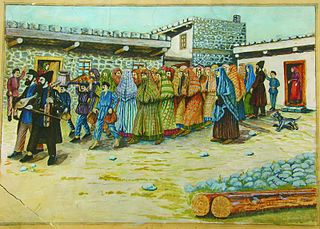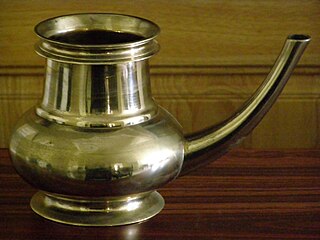
Show jumping, also known as "stadium jumping", is a part of a group of English riding equestrian events that also includes dressage, eventing, hunters, and equitation. Jumping classes are commonly seen at horse shows throughout the world, including the Olympics. Sometimes shows are limited exclusively to jumpers, sometimes jumper classes are offered in conjunction with other English-style events, and sometimes show jumping is but one division of very large, all-breed competitions that include a very wide variety of disciplines. Jumping classes may be governed by various national horse show sanctioning organizations, such as the United States Equestrian Federation in the USA or the British Showjumping Association in Great Britain. International competitions are governed by the rules of the International Federation for Equestrian Sports. Horses are very well-known for jumping in competition or even freely.

Calligraphy is a visual art related to writing. It is the design and execution of lettering with a broad-tipped instrument, brush, or other writing instrument. A contemporary calligraphic practice can be defined as "the art of giving form to signs in an expressive, harmonious, and skillful manner".

Ablution, in religion, is a prescribed washing of part or all of the body or possessions, such as clothing or ceremonial objects, with the intent of purification or dedication. In Christianity, both baptism and footwashing are forms of ablution. Prior to praying the canonical hours at seven fixed prayer times, Oriental Orthodox Christians wash their hands and face. In liturgical churches, ablution can refer to purifying fingers or vessels related to the Eucharist. In the New Testament, washing also occurs in reference to rites of Judaism part of the action of a healing by Jesus, the preparation of a body for burial, the washing of nets by fishermen, a person's personal washing of the face to appear in public, the cleansing of an injured person's wounds, Pontius Pilate's washing of his hands as a symbolic claim of innocence and foot washing, now partly a symbolic rite within the Church. According to the Gospel of Matthew, Pontius Pilate declared himself innocent of the blood of Jesus by washing his hands. This act of Pilate may not, however, have been borrowed from the custom of the Jews. The same practice was common among the Greeks and Romans.

A seashell or sea shell, also known simply as a shell, is a hard, protective outer layer usually created by an animal that lives in the sea. The shell is part of the body of the animal. Empty seashells are often found washed up on beaches by beachcombers. The shells are empty because the animal has died and the soft parts have been eaten by another animal or have decomposed.

Laundry refers to the washing of clothing and other textiles. Laundry processes are often done in a room reserved for that purpose; in an individual home this is referred to as a laundry room, Laundry in Australian English or utility room. An apartment building or student hall of residence may have a shared laundry facility such as a tvättstuga. A stand-alone business is referred to as a self-service laundry. The material that is being washed, or has been laundered, is also generally referred to as laundry.

A washing machine is a home appliance used to wash laundry. The term is mostly applied to machines that use water as opposed to dry cleaning or ultrasonic cleaners. The user adds laundry detergent, which is sold in liquid or powder form, to the wash water.

Abu Yūsuf Yaʻqūb ibn ʼIsḥāq aṣ-Ṣabbāḥ al-Kindī was an Arab Muslim philosopher, polymath, mathematician, physician and musician. Al-Kindi was the first of the Islamic peripatetic philosophers, and is hailed as the "father of Arab philosophy".

Placer mining is the mining of stream bed (alluvial) deposits for minerals. This may be done by open-pit or by various surface excavating equipment or tunneling equipment.

Ritual purification is the ritual prescribed by a religion by which a person is considered to be free of uncleanliness, especially prior to the worship of a deity, and ritual purity is a state of ritual cleanliness. Ritual purification may also apply to objects and places. Ritual uncleanliness is not identical with ordinary physical impurity, such as dirt stains; nevertheless, body fluids are generally considered ritually unclean.

Maundy, or the Washing of the Feet, or Pedelavium, is a religious rite observed by various Christian denominations. The name is taken from the first few Latin words sung at the ceremony of the washing of the feet, "Mandatum novum do vobis ut diligatis invicem sicut dilexi vos", and from the Latin form of the commandment of Christ that we should imitate His loving humility in the washing of the feet. The term mandatum (maundy), therefore, was applied to the rite of foot-washing on this day of the Christian Holy Week called Maundy Thursday.
Rawhide is a hide or animal skin that has not been exposed to tanning. It is similar to parchment, much lighter in color than leather made by traditional vegetable tanning.

A lota, a type of spouted vessel made of brass, copper or plastic used in Indian subcontinent, specially in the Indian-origin religions, since at least 2nd millennium BC. In the Indian-origin religions, the copper lota has sacred usage, such as in yagna ritual during puja prayers, weddings and other sacred ceremonies. According to the ancient Indian/Hindu-origin traditional medicine system of ayurveda, drinking water stored in the copper lota has health and nutritional benefits.

A car wash or auto wash is a facility used to clean the exterior and, in some cases, the interior of motor vehicles. Car washes can be self-serve, fully automated, or full-service with attendants who wash the vehicle. It may also be an event where people pay to have their cars washed by volunteers as a method to raise money for some purpose.

A lavabo is a device used to provide water for the washing of hands. It consists normally of an ewer or container of some kind to pour water, and a bowl to catch the water as it falls off the hands. In ecclesiastical usage it refers to all of: the basin in which the priest washes his/her hands; the ritual that surrounds this action in the Catholic Mass; and the architectural feature or fitting where a basin or place for one is recessed into the side wall of the sanctuary, or projects from it. If this last includes or included a drain, it is a piscina used for washing the church plate and other fittings, though the terms are often confused. In secular usage, it is an obsolete term for any sink or basin for washing hands, especially in a lavatory.

The jutti or Punjabi Jutti is a type of footwear common in North India and neighboring regions. They are traditionally made up of leather and with extensive embroidery, in real gold and silver thread as inspired by Indian royalty over 400 years ago. Prior to that, Rajputs of the northwest used to wear leather juttis.jutti also called ethnic shoes Now with changing times, different juttis with rubber soles are made available. Besides the Punjabi jutti, there are various local styles as well. Today Amritsar and Patiala are important trade centers for handcrafted juttis, from where they are exported all over the world to Punjabi diaspora. Closely related to mojaris. Juttis have evolved into several localized design variations, even depending upon the shoemaker. However by large, they have no left or right distinction, and over time take the shape of the foot. They usually have flat sole, and are similar in design for both women and men, except for men they have a sharp extended tip, nokh curved upwards like traditional moustaches, and are also called khussa, and some women’s juttis are backless. Even with changing times juttis have remained part of ceremonial attire, especially at weddings, the unembellished juttis are used for everyday use for both men and women in most of Punjab, mostly called Jalsa Jutti which is blackish in color.

Stone walls are a kind of masonry construction that has been used for thousands of years. The first stone walls were constructed by farmers and primitive people by piling loose field stones into a dry stone wall. Later, mortar and plaster were used, especially in the construction of city walls, castles, and other fortifications before and during the Middle Ages. These stone walls are spread throughout the world in different forms. One of the best example is the Cyclopean Wall in Rajgir, India.

Etiquette in Asia varies from country to country even though certain actions may seem to be common. No article on the rules of etiquette, nor any list of faux pas, can ever be complete. As the perception of behaviors and actions vary, intercultural competence is essential. A lack of knowledge about the customs and expectations of Asian people can make even those with good intentions seem rude, foolish, and disrespectful.
In certain denominations of Christianity, hygiene in Christianity includes a number of regulations involving cleanliness before prayer, as well as those concerning diet and apparel.

Aftabeh, also called obdasta is a pitcher made out of clay, copper, brass, or plastic which is used traditionally for purposes of hand washing, cleansing, and ablution. Its overall shape is similar to a ewer with an angled spout protruding from its side, from where water is poured. It shares resemblance with lota and kindi in Indian culture.

A cantharus, also known as a phiala, is a fountain used by Christians for ablution before entering a church. These ablutions involve the washing of the hands, face, and feet. The cantharus is traditionally located in the exonarthex of the church. The water emitted by a cantharus is to be running water. The practice of ablutions before prayer and worship in Christianity symbolizes "separation form sins of the spirit and surrender to the Lord." Eusebius recorded this practice of canthari located in the courtyards of churches, for the faithful to wash themselves before entering a Christian house of worship. The practice has its origins Jewish practice of performing ablutions before entering into the presence of God. Though canthari are not as prevalent anymore in Western Christianity, they are found in Eastern Christian and Oriental Christian churches.


















